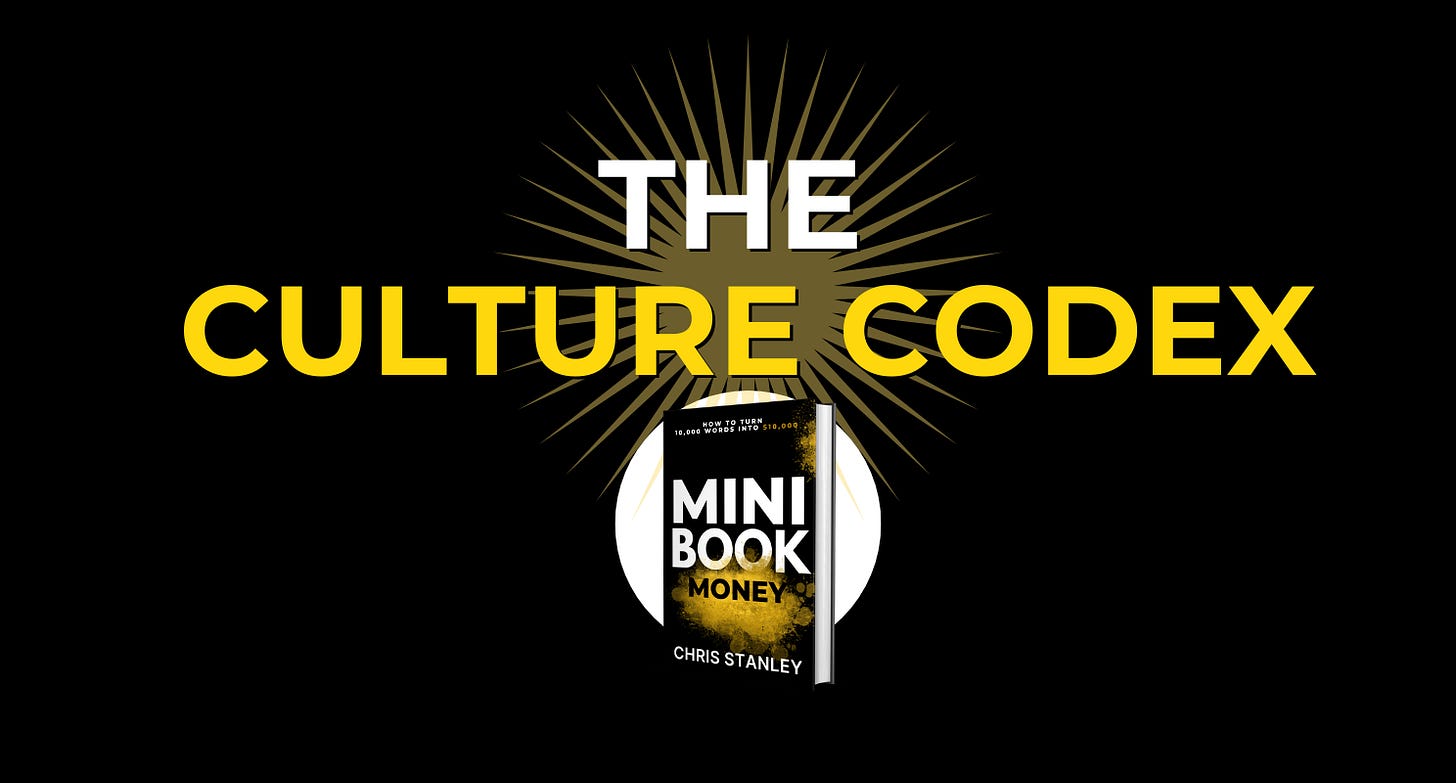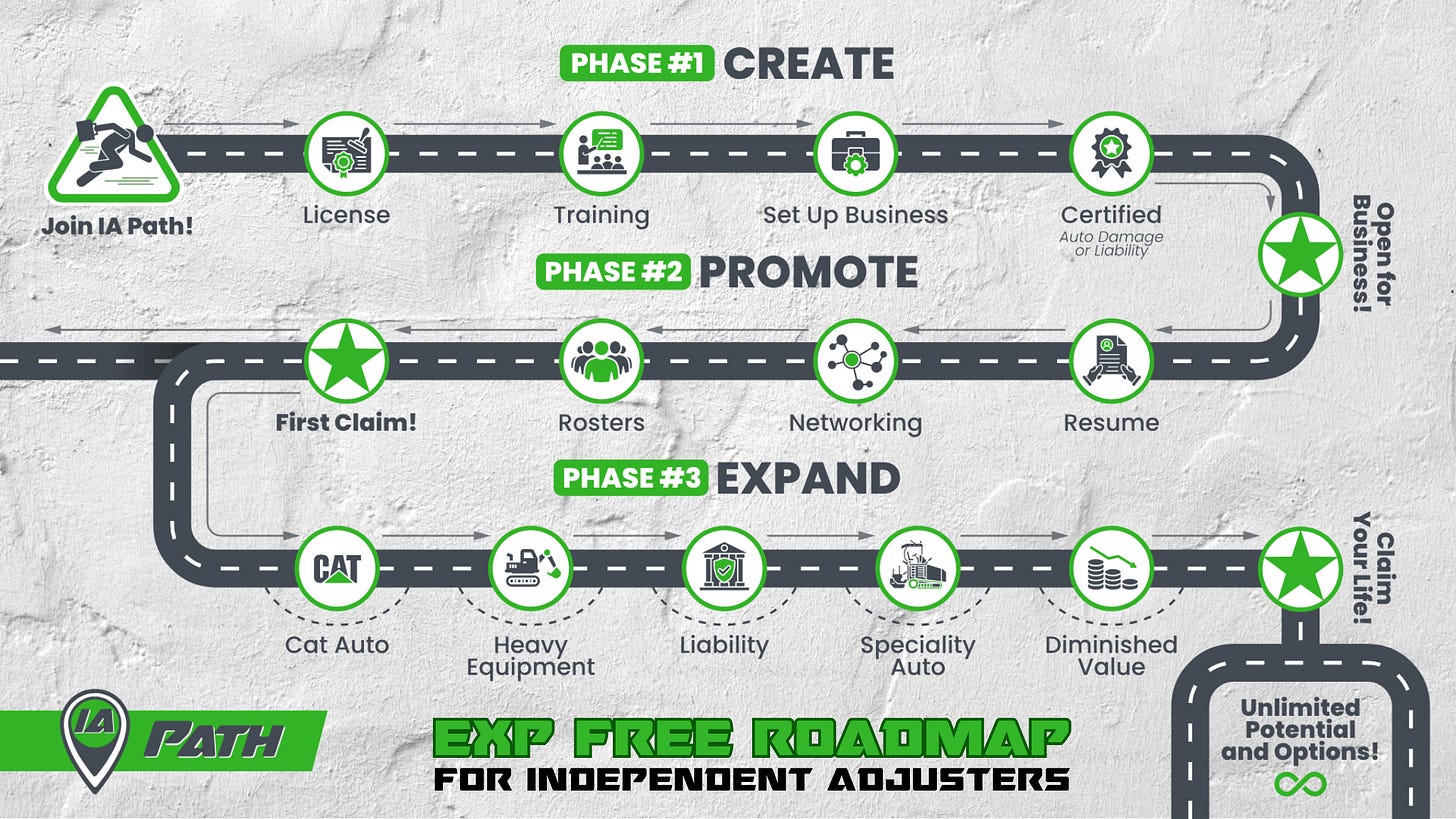The Culture Codex: Where Your Book Becomes a Movement
Final Chapter of Mini Book Money
Hey Revenue Writers,
Most of the time, when I finish a new chapter, it goes straight behind the premium subscriber wall. (maybe a free preview)
But this one… felt different.
This isn’t just a chapter. It’s a shift in how I see the future of small business, publishing, and belief. It’s the final chapter from Mini Book Money, and I usually reserve these kinds of drops for paying members, but I couldn’t keep this one locked up.
It’s called The Culture Codex and if you’ve ever wondered how to preserve what matters most as you scale, especially in the age of AI and noise, or how to build a raving fanbase or community, I think this will hit home.
You can read the full thing here, no paywall.
Read it, sit with it, and if it changes how you see your work, share it.
- Chris
The Culture Codex: Where Your Book Becomes a Movement
Your product will be forgotten.
The money will be spent. The email will be deleted. The launch will come and go without a trace. But if you change someone’s life, they will carry your words with them forever.
Transformation is the only thing that leaves a mark.
Culture is the imprint you leave when the content is gone.
It shapes how people think, speak, and see themselves. Even if your business disappears, your impact remains in their habits, their language, and their future.
Movements begin when your message becomes who they are.
1. Belief – The Manifesto
Movements are born from frustration, from people who are done with the way things are.
Your manifesto begins by naming that frustration. It identifies the problem your audience is facing and offers a bold new belief system in response. The manifesto does not just describe the work, they already know what they do. It declares who they are, what they stand for, and where they are going.
If your book is the invitation, the manifesto is the battle cry.
When I launched the Independent Adjusters Podcast at IA Path, I knew the problem: no one was helping new adjusters get work.
The system was built on silence, secrecy, and gatekeeping. People were waiting to “get lucky.” So we flipped the story. We declared, “I create my own opportunities. I define my own success.” That message spread fast, because it wasn’t just information, it was a mindset shift. It gave people power, language, and a mission.
The manifesto worked because it was not about me. It was about them.
Here is the exact language I used to spark my first wave of community on accident. This was the opening of my podcast and it became something people reference years later at something that made them want to run through a wall with excitement.
"So here's the question, how do independent adjusters and appraisers like us, who can't hide behind corporate logos, processes, and profits, who are spending our own money and reputation, how do we work in a way that lets us get work, assignments, deployments, and more income without wasting time or money in this world of insurance while we stand out in the crowd? That is the question, and this podcast will help guide you to the answers.
My name is Chris Stanley, and this is the Independent Adjuster podcast. Join myself and other independents on the path to non-corporate success in the insurance industry. We are IA's."
What Goes Into a Manifesto
A powerful manifesto contains six key elements:
1. The Problem What is broken? What are people fed up with? What no longer works?
2. Identity Who is your reader becoming? Give them a name they can wear with pride.
3. Values What principles does this new identity live by?
4. Actions How do people in this culture behave, decide, and act?
5. Vision What’s the bigger transformation? What kind of world are they building?
6. Rallying Cry What is the one bold sentence they can say, post, or shout to claim it?
The manifesto is not just content, it’s culture, captured.
Once you write it, it becomes the source of all your messaging, your taglines, your product names, your mission. It is what makes your brand feel like a belief system. It is the fuel that turns your audience into advocates.
You’re not just giving them something to read. You’re giving them something to live by.
Belonging - Aspirational Identity
People do not follow information. They follow identity.
Once you’ve named the problem and cast the vision, your audience wants to know: “Who do I become if I believe this?” That’s where the aspirational identity comes in. This is the most important part of the manifesto. It is the handle they grab onto. The word they repeat. The name they proudly wear.
If your message is the map, the identity is the uniform.
"IA (Independent Adjuster)" wasn’t just a job title, it became a way of life.
When people started listening to the podcast, they didn’t just consume content. They adopted language. They took on values. They shared slogans like “I’m not playing the Adjuster Lottery” and “I'm claiming my life.” They found themselves in a community that spoke the same way, believed the same things, and acted with the same purpose.
The identity turned followers into insiders and insiders into advocates.
We didn’t just teach people how to become independent adjusters, we taught them to stop waiting and start owning.
"IA" was the first identity we gave them. But "Pathfinder" was the deeper one. A Pathfinder didn’t wait to be picked. A Pathfinder didn’t play the Adjuster Lottery. They created their own opportunities, built their own relationships, and treated their career like a business, not a job.
We gave them a name and then we gave that name a mission.
That identity changed how they talked, how they acted, and what they expected of themselves.
They believed that being a Pathfinder meant something. It gave them pride and accountability. They weren't just listeners, they were part of something bigger.
The moment you give people a name they believe in, they rise to live up to it and tell others about it.
Behaviour - What Behavior Means in a Movement
Belief gives people conviction.
Belonging gives them identity.
Behavior gives them direction.
Once someone believes in a transformation and feels like they’re part of a group that can help them get there, they want a clear answer to the question, “What do I do now?” Behavior is where you translate values into action. Without direction, even the most inspired community stalls.
Culture needs a compass, not just a mission.
Behavior becomes real when it’s organized into a path.
Not just a list of things to try, but a roadmap. A repeatable, teachable system that helps someone act like one of “us.” This could be a five-step framework, a series of challenges, a course structure, or weekly rituals. When action is structured, people move with confidence and consistency.
Movement thrives on repeatable steps.
Case Study: IA Path and the 7-Step Pathfinder Journey
At IA Path, we turned identity into behavior through a 7-step process. (which also became my first mini book for adjusters!)
You can see the current roadmap below. (the first 7 steps and then future things they can do after they get work)
We called our community members “Pathfinders,” and if you give someone a name like that, you better give them a path. So we built it. The process became the container for our behavior, what Pathfinders do, how they think, how they take control of their career, what certifications they should get.
Belief told them it was possible, but the path told them how.
We delivered that behavior through tools, structure, and community.
Every step had content to support it. Courses, templates, videos, coaching calls, and peer support. The behavior was not vague or idealistic. It was specific and actionable. That’s why people didn’t just listen to the podcast. They changed careers.
Behavior made our brand a movement, it became our fuel for our business.
Caution About Communities
The community begins the moment you publish.
From day one, your language, your message, and your identity start shaping how people see themselves. That’s your culture being born. But turning it into a paid product too early will crush you. It takes time, systems, and momentum to hold that kind of container.
You don’t build a community with products. You build it with people.
I don’t recommend launching a paid community until you’ve done at least $100,000 in sales. (maybe even more)
You need experience, clarity, and proof that people want more. Once you’ve sold courses, books, coaching, or services, and you’re consistently earning, then you’re ready to wrap it all in community. That’s when it becomes your retention engine, your support system, and your highest-value offer.
Build the belief first and charge for the belonging later.
Our community became the most loved and most profitable part of our $5,000 coaching program.
After graduation, students could stay for just $500 a year and nearly all of them did. The community became the hub where we delivered content, support, interaction, and connection. Many stayed for two or three years, not just because of the content, but because of the culture.
The community turned students into lifers.
The $10K Culture Codex
A paid community is not about the platform, but it’s about belief, belonging, and behavior.
If you’ve laid the groundwork, and you’re earning consistently from books, coaching, or courses, here’s how to build a $10K+ community around your message:
1. Choose a Platform That Fits Your Flow
Start simple. Circle, Mighty Networks, Skool, and Thinkific Communities all work. Pick what matches your energy and technical comfort. Don’t obsess over features. Obsess over connection.
2. Name the Group After the Identity
Your group name should sound like who they already believe they are. If your audience calls themselves Revenue Writers, Pathfinders, or Freedom Seekers, use that. The name makes it feel like home before they even join.
3. Build Your Behavioral System First
What do members do once they’re inside? Lay out your 3, 5, or 7-step process. Create weekly rituals, challenges, or templates that guide them through the transformation. People don’t pay to sit in a forum. They pay to move. Make sure they make progress and reach their destination!
4. Use the Community to Deliver Everything
Make this your content hub. Drip coaching, run trainings, release templates or whatever else you’re offering, deliver it here. It’s not just a community. It’s your operating system for transformation.
5. Price for Commitment, Not Volume
$500 a year from 20 people = $10,000. That’s your starting goal. You don’t need scale. You need the right 20 people who see this as their tribe and their transformation.
You don’t build a community and hope people buy in.
You build belief, belonging, and behavior then give them a place to live.




